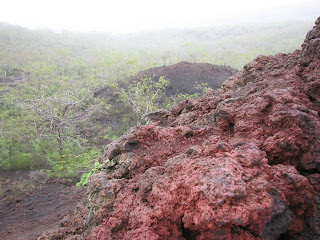Sunday, March 21, 2010
Wild Places and In the Footsteps of Darwin
S/V Aspen – March 22, 2010 – Log #34
Position: 00 degrees 47.0’ S 90 degrees 05’ W
Santa Cruz Island, Galapagos Islands
Aspen is anchored at Puerto Ayora, Santa Cruz Island, Galapagos, Equador. This is one of the two places that we are allowed to anchor within all of the Galapagos Islands. However, since we landed at Puerto Ayora, now we are not even allowed to go anywhere else with Aspen without a very expensive and long permitting process. Yet our entry permit only permits us to stay here 20 days before we must leave so getting another permit is not possible!
Instead, we signed up on one of the small cruise ships that travel throughout these island and took a 5 day trip and visited 6 different islands.
There are few truly wild places left on Earth. The Galapagos Islands are definitely one of them. We were not sure what to expect when we arrived here but what we have seen has easily surpassed our wildest dreams!
Active volcanos are everywhere! In fact there are 14 active volcanos in the Galapagos Islands, more than anywhere on earth. The Galapagos Islands are very young islands, less than 2.5 million years or about a blink of an eye in geologic time. We walked among spatter cones, lava tubes, on layers of tuff, Pahoe-hoe and Aa lavas and slid on the slopes of cinder cones. Captain Steve filled his memory stick with photos of these landscapes. Maria also enjoyed hiking to the top of the calderas, peering at Darwin's Lake where Charles Darwin himself sat mesmerized by the grandeur that is the Galapagos in 1835. Luckily the volcanos were quiet this week as we wandered amongst them!
Charles Darwin set forth his Origin of species while visiting these islands. We visited the exact place where his ship, the Beagle, anchored while Darwin explored the wildness that defined evolution. Darwin's revolutionary book, Origin of Species, was written while he was sailing and visiting in the Galapagos Islands.
Since these islands are very recent in origin, the observation and study of the animals above and below the earth's surface was done prior to the impact of man. Even today, these islands are severely restricted and travel among them is extremely limited.
That is the reason we were able to walk right next to giant tortoises, huge iguanas, brilliant red crabs, swim with sea lions, seals, penguins and sharks as well as watching blue footed boobies, pelicans and finches darken the skies. Killer whales played in our wake as we sailed by. The variety of life here is staggering, especially considering that life in the Galapagos began with creatures swimming, floating or flying here from the distant shores of South America and Central America.
The Galapagos Islands today truly are one of the wild places to visit on Earth.
But our time here is limited as we said. The winds want to fill our sails and push us westward to the magic islands of the South Pacific. This week we will lift our anchor and ride the winds westward toward the setting sun.
Sail on sail on Aspen...
Steve and Maria
Subscribe to:
Post Comments (Atom)



















No comments:
Post a Comment